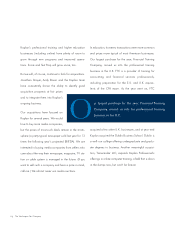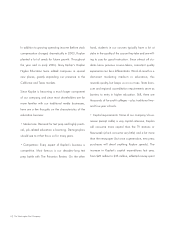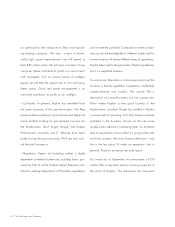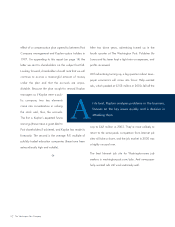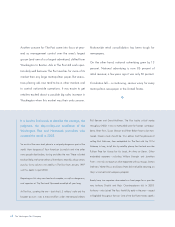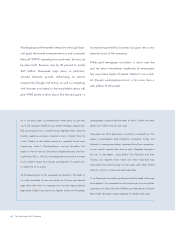Washington Post 2003 Annual Report Download - page 16
Download and view the complete annual report
Please find page 16 of the 2003 Washington Post annual report below. You can navigate through the pages in the report by either clicking on the pages listed below, or by using the keyword search tool below to find specific information within the annual report.
14 The Washington Post Company
September 29, 2003
To Our Shareholders:
Today we are offering to repurchase about 55 percent of the option
shares in the stock option compensation plan of our subsidiary
Kaplan, Inc. (about 6 percent of Kaplan’s total stock). I write about
this offer at some length because the Kaplan compensation plan is
both complex and significant to the company.
If our offer is successful, the company will spend approximately
$138 million to buy out these options, including a 10 percent pre-
mium over the share price, contingent upon the tendering of 90 per-
cent of eligible shares. Most of this will be paid out in the fourth
quarter of 2003 from cash generated by operations or from com-
mercial paper borrowings.
As of June 30, 2003, the company had accrued approximately
$103 million to meet the estimated liabilities of the whole plan. The
company will record additional accruals of approximately $75 mil-
lion and $13 million in the third and fourth quarters, respectively.
Jonathan Grayer, Kaplan’s CEO, and a small number of other key
Kaplan executives will continue to hold some options in the Kaplan
compensation plan. Roughly half of the remaining options expire in
2007, half in 2011.
The Post Company bought Kaplan from its founder, Stanley
Kaplan, in 1984 for $45 million. At the time, Kaplan was earning
about $8 million a year. Strong competition and less-than-success-
ful attempts at finding the right manager to succeed Stanley affected
our results, and by the early ’90s, Kaplan was losing money. In 1994,
the 29-year-old Jonathan Grayer became CEO. Kaplan immediate-
ly started taking aggressive steps to improve the business.
In 1997, although losses were continuing, Post Company manage-
ment was satisfied enough with the trends of the business to imple-
ment the Kaplan compensation plan. Good young managers were
at a premium and we wanted the best possible chance of keeping
our team together. The program allowed 64 current Kaplan
employees the option to acquire stock in Kaplan. Fifteen percent of
the stock of Kaplan was optioned (subsequent equity purchases by
The Washington Post Company to finance growth reduced this to
10.6 percent).
The Post Company Compensation Committee, advised by an outside
firm, values the stock annually as if Kaplan were a public company.
After a vesting period, Kaplan option holders can exercise their
options and sell the stock to us at any time. Because there is no pub-
lic market for the stock, we are required by GAAP to expense a “stock
compensation charge.” The Committee establishes the annual valu-
ation of Kaplan by considering several factors, including Kaplan’s
budget for the forthcoming year, its earnings for the previous years,
and the price/earnings multiples of comparable publicly traded edu-
cation companies, which can affect valuations meaningfully.
ADDENDUM


